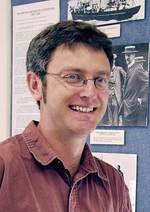From Snowball Earth to outback glaciers
 Geology Geology
Is it possible that the earth lost its balance 800 million years ago and rolled over on its side to restore equilibrium? It's a wild idea but Dr Galen Halverson, one of the world's leading geoscientists studying this time period, is helping to provide compelling evidence of this shift. Dr Halverson, a new recruit to the Discipline of Geology & Geophysics within the School of Earth & Environmental Sciences, is co-author of a paper published last year which presents evidence in support of the Inertial Interchange True Polar Wander theory. The theory suggests that under certain conditions, the redistribution of masses in the interior of the earth can cause the entire earth to rotate by up to 90° perpendicular to the spin axis, such that land masses on the poles would move to the equator. In principle, it means Alaska could have moved to the equator in the earth's distant past in just a few million years. Dr Halverson and a team led by Princeton University geoscientist Adam Maloof advanced the theory after analysing the magnetic composition of ancient sediments found in the remote Norwegian archipelago of Svalbard, dating from 800 million years ago. They are now testing the hypothesis by studying rocks of the same age in Australia. The contentious finding is one of two major discoveries the American geoscientist has been involved with in recent years. The other theory that made a big splash in the scientific community was back in 1998 when Dr Halverson co-authored a paper which explained an ancient climatic paradox. For decades geologists had struggled to explain evidence of glacial deposits that formed near the equator and at sea level in low latitudes some 650 million years ago. Rocks found in the Flinders Ranges in South Australia actually provided the world's scientific community with the best evidence that the Earth was once entirely locked in ice. In the late 1990s, Dr Halverson and his PhD supervisor at the time, Paul Hoffman, found anomalies in the ratios of carbon isotopes in ancient sediments that suggested a rapidly cooling earth brought life to a halt for millions of years. This glaciation ended abruptly when a greenhouse-induced effect kicked in, turning the entire planet into a sauna for a few million years, until Earth's climatic thermostat could cool it off again. This hypothesis, widely known as the Snowball Earth theory, was written up by Hoffman, Dr Halverson, and two colleagues, Alan Kaufman and Daniel Schrag in the journal Science in 1998. The hypothesis continues to attract worldwide attention, but remains highly controversial. Dr Halverson joined the University of Adelaide in November 2006 from Toulouse, France, where he worked for two years as a postdoctoral researcher funded by the National Science Foundation in the US. He completed his PhD in Geology at Harvard University in 2003, researching climatic and environmental change in the Neoproterozoic Era (1000 to 542 million years ago). An isotope geochemist, Dr Halverson has carried out most of his fieldwork in the Arctic and southern Africa, but South Australia is a new frontier for him. "Joining the University of Adelaide presents a fantastic opportunity for me because South Australia is one of the world's focal points for the study of the late pre-Cambrian era," Dr Halverson said. "A lot of the international work on this era has been carried out in the Adelaide Hills and Flinders Ranges, where there is evidence of ancient glacial deposits. "This was arguably one of the most interesting times in our history because there was so much going on. There were a series of large global glaciations and it appears that the earth's environment became fully oxygenated at this time. "Another attraction that South Australia presents is the number of excellent recent sediments from 40,000 years ago to the present day," he said. Story by Candy Gibson
|






